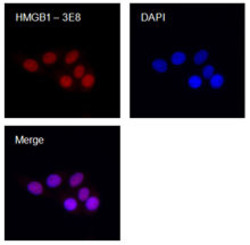Antibody data
- Antibody Data
- Antigen structure
- References [0]
- Comments [0]
- Validations
- Western blot [1]
Submit
Validation data
Reference
Comment
Report error
- Product number
- 651402 - Provider product page

- Provider
- BioLegend
- Proper citation
- BioLegend Cat#651402, RRID:AB_10916522
- Product name
- Purified anti-HMGB1
- Antibody type
- Monoclonal
- Antigen
- Recombinant human HMGB1 with GST tag. A universal T cell epitope from a Mycobacterium tuberculosis antigen was introduced into the C-terminus of HMGB1 to increase the immunogenicity.
- Description
- High mobility group protein B1 (HMGB1) belongs to a family of highly conserved proteins that contain HMG box domains. Human HMGB1 is expressed as a 215 amino acid (aa) single chain polypeptide containing three domains: two N-terminal globular, 70 aa positively charged DNA binding domains (HMG boxes A and B), and a negatively charged 30 aa C-terminal region that contains only Asp and Glu. Human HMGB1 is 100% aa identical to canine HMGB1 and 99% aa identical to mouse, rat, bovine and porcine HMGB1.HMGB1 is a widely expressed and highly abundant protein. It was originally discovered as a nuclear protein that could bend DNA. Such bending stabilizes nucleosome formation and regulates the expression of select genes upon recruitment by DNA binding proteins. It is now known that HMGB1 also plays a significant role in extracellular signaling associated with inflammation. HMGB1 is massively released into the extracellular environment during cell necrosis. It acts as an inflammatory mediator that promotes monocyte migration and cytokine secretion, and as a mediator of T cell-dendritic cell interaction. In addition, activated monocytes, macrophages, and dendritic cells also secrete HMGB1, forming a positive feedback loop that results in the release of additional cytokines and neutrophils. The cytokine activity of HMGB1 is restricted to the HMG B box, while the A box is associated with the helix-loop-helix domain of transcription factors. Although HMGB1 does not possess a classic signal sequence, it appears to be secreted as an acetylated form via secretory endolysosome exocytosis. Once secreted, HMGB1 transduces cellular signals through its high affinity receptor, RAGE and, possibly, TLR2 and TLR4.
- Reactivity
- Human, Mouse, Rat
- Host
- Mouse
- Conjugate
- Unconjugated
- Isotype
- IgG
- Vial size
- 100 µg
- Concentration
- 0.5 mg/ml
- Storage
- Upon receipt, store undiluted at 4°C.
No comments: Submit comment
Supportive validation
- Submitted by
- BioLegend (provider)
- Main image

- Experimental details
- Hela cells were stained with anti-HMGB1 antibody, clone 3E8, followed by DyLight⢠549 conjugated anti-mouse IgG. Nuclei were stained with DAPI.
- Conjugate
- Unconjugated
 Explore
Explore Validate
Validate Learn
Learn Western blot
Western blot Immunocytochemistry
Immunocytochemistry Blocking/Neutralizing
Blocking/Neutralizing